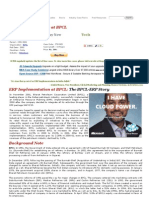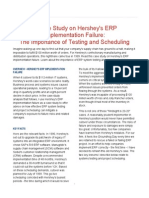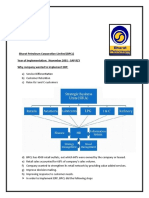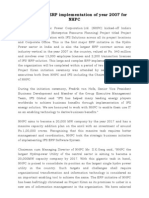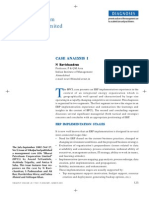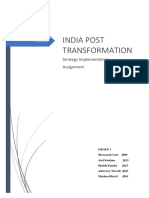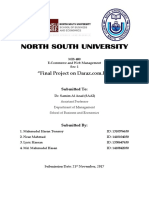HPCL
HPCL
Uploaded by
abhipsa_dashOriginal Description:
Copyright
Available Formats
Share this document
Did you find this document useful?
Is this content inappropriate?
Report this DocumentCopyright:
Available Formats
HPCL
HPCL
Uploaded by
abhipsa_dashCopyright:
Available Formats
Hindustan Petroleum Corporation Limited (HPCL), whose roots go back to 1952, is today operational in the oil refinery and
LPG distribution space. A Fortune 500 company, HPCL recorded an annual turnover of over Rs 91,448 crores for the financial year ended March 2007. Currently, the company enjoys a 16 percent refining and marketing share in India and a strong market infrastructure. The company has successfully completed Asia's largest JD Edwards Enterprise One ERP implementation spanning about 400 locations and 4,000 employees across the nation. Need for ERP In a fiercely competitive petroleum industry, keeping partners happy is an imperative. But HPCL was slowly facing the heat from its dealers. The problem was its manual process that made human errors a big possibility. All this changed when HPCL implemented an elegantly simple SMS solution that helped the company improve efficiency and save the day. What was annoying was that the order processing was standard business practice. For dealers, placing an indent - an order which typically holds the amount of oil that a dealer requires was just another thing that needed to be done every so often. But the process was painful. Sometimes, dealers complained that when an HPCL official finally picked up the phone, he or she got their order wrong or recorded it on their systems incorrectly or misplaced their order. The epicenter of dealer unrest, however, was a terminal in southern India. With the increasing number of complaints it was getting, HPCL knew that if it neglected the problem, it could prove costly. So, the company conducted an internal study and the result has saved it a world of trouble. The implementation Plan The ERP implementation programme was started way back in 2000. The availability of a sound technical infrastructure was necessary for implementing such a large initiative. This meant building a centralised data centre where the servers and applications could be hosted as well as having efficient connectivity for all locations spread across India's geography. Around 400 locations had to be connected. One of the important initial tasks was to build a data centre equipped with servers and the related infrastructure required for rolling out applications. To start with, HPCL covered three locations within a month; ultimately, all 400 locations were completed over a period of twoand-a-half years. As each location was selected for inclusion, the related infrastructure (like WAN, lease lines, VPN and VSATs) was built simultaneously depending on the availability. The DC, based in Mumbai, was powered with adequate computing capacity to enable it to handle the expected growth in the wake of the ERP rollout. The company is now building another DC in Hyderabad, which is visualised as a primary DC. By the end of 2008, they moved their applications to Hyderabad. The company runs a refinery in Vizag and has also made significant investments in the state, so Hyderabad was a natural choice for the new DC. As HPCL enjoys a national presence, it was important to determine the path for the ERP
rollout. Several business processes were analysed for determining the points affecting the process look. They came to the conclusion that the roll out should follow the logical movement of the product. Thus, the ERP roll out started with locations in and around Mumbai, followed by other Maharashtra and Gujarat locations, and finally, covered the entire footprint of all 400 locations. As per their strategy, they tried their best to get every possible and available means of connectivity. BSNL was the only player in the connectivity space at that time. It provided a connectivity platform for most locations; however, for distant locations HPCL had to depend on VSATs. Over a period of time, as newer options like RF and broadband networks entered the market, they were embedded into the existing set-up. Today, HPCLs network is a hybrid one powered by lease lines, VSATs, VPN, RF links and broadband links. The company operates on BSNL's MPLS as well as a private service providers MPLS network for redundancy. The ERP implementation at HPCL, with all its challenges and successes, finally saw the light of the day in December 2005 at an organisation-wide level.
HPCL continually invests in innovative technologies to enhance the effectiveness of employees and bring qualitative changes in service. Business Process Re-Engineering exercise, creation of Strategic Business Units, ERP implementation, Organizational Transformation, Balanced Score Card, Competency Mapping, benchmarking of refineries and terminals for product specifications, ISO certification of Refineries and Supply Chain Management are some of the initiatives that broke new grounds. HPCL has successfully integrated Information Technology in its activities at different levels. The Enterprise Resource Planning (ERP) system is now operational on J.D.Edwards, an Oracle product, across the Corporation. Alignment of In-house and Vendor Teams The project was kicked off with a 25 member in-house team comprising representatives from all functional areas. Post the completion of the first phase of the project, which included system configuration, more employees were inducted into the team and its size now expanded to 100 people. In addition to this, a team of 100 consultants was also working from Capgeminis side, which was chosen to be the implementation partner for the project. The company had set up a separate team for infrastructure building at each location. Based on the roll out schedule, the lead time for infrastructure provision was calculated for each location. The infrastructure team had to reach the respective locations on the basis of the lead time available so that the roll out team could initiate the work as per schedule. Planning and monitoring human resource mobilisation from various teams to various locations was a challenge for the company. The locations due for the 'Go-Live' stage in a particular month were given top priority and a 'work backwards' system was followed to arrive at separate tasks and their deadlines for those locations. These tasks included procurement of hardware, applications for communication links, and testing and liasioning with local people at the location. This kind of systematic planning helped the company to reap the maximum benefits of its HR pool and consulting team.
Business Process Speed Enhancement & Standardisation: Major Benefits Post implementation, the company has noticed substantial improvement in efficiencies. For example, before the implementation, the annual financial accounts closure would approximately take a month while the monthly closing would consume 15 to 20 days. In the past year i.e. 2007-08, the monthly and quarterly closing was completed in about five days while the annual closing took a mere 10 to 12 days. The second major benefit of the centralised ERP implementation was that it compelled the company to look at various other services that could be offered to customers with the help of IT. They realised that they could improve their transparency by making more information available to their customers, vendors and transporters on a real-time basis with the help of the Internet so that they can log in and check the status of loads, orders, and payments. The implementation gave the company an opportunity to re-look at all its business processes from the beginning. A lot of processes like manufacturing planning, procurement and employee benefits that were being implemented manually previously are now automated. The company is now looking at an IT-efficient growth strategy for the future. Visibility Benefits for Top Management The ERP enabled the generation of various day-end MIS reports on a regular basis. This helped to revamp the way in which reporting was done to the top management. The IT team went ahead and equipped the top management with Information portals to better their business visibility. They used the concept of portals whereby the top management could quickly view the summarised information online. At the end of the day, a lot of transaction details were summarised and converted into a pre-packaged MIS before reaching the top management. Factors That Shaped the Success Story The success of the implementation to four main factors - the expertise of the internal team; the right implementation partner; commitment and support from the top management; and effective project management practices. They had experts from finance, refinery, marketing and LPG departments. These were people who knew the business line. They brought in that knowledge to add to the expertise of the IT team. This helped the project to gain a macro, company-level perspective. The HPCL ERP implementation can be exemplary to other large organisations wishing to derive benefits from IT adoption.
ERP Drives Parivartan at HPCL Ever since the government of India announced deregulation of the oil industry in 2002, HPCL had undertaken a Business Process Reengineering (BPR) study to ready the organization for post deregulation market conditions. They had to be prepared to take on the Shells and the Exons of the world.
One of the major recommendations of the BPR was the implementation of a world class ERP system. The implementation of the ERP system would enable the corporation to meet the challenges of the emerging market scenario. Project Parivartan is HPCLs initiative to implement Oracle s JD Edwards EnterpriseOne, an ERP solution. The implementation covers all the modules of the ERP software viz. sales & distribution, manufacturing, finance and HR. Customized modules to suit HPCL processes have been developed for employee compensation & benefits and also payroll and both integrated with finance and HR modules of the software. Team set up and implementation partner A multi functional team of 25 officers drawn from various functional departments was set up for undergoing detailed training on the JDEdwards ERP system and take up the implementation across the corporation, in 2000-01. This team strength was augmented over time especially in the rollout phase. After completion of the training, the team documented the As-Is processes of the corporation. The implementation partner was selected from the consulting partners of JDEdwards. The contract for the Conference Room Prototype (CRM) and pilot implementation was awarded to Capgemini and Ernst & Young,. CRP and pilot roll out The pilot implementation project was divided into various phases. * Validation of as-IS processes * Finalization of the technical architecture and the hardware/software requirements * Finalization of interfaces/customizations * Configuration & testing of the Conference Room Prototype (CRP) for business processes of the Corporation * Roll out at the pilot locations Based on the technical architecture, the corporation parallely placed the order for the architecture components and set up the data centre at Mumbai.
The implementation at pilot locations was preceded by comprehensive simulation & testing of the solution by building a CRM. All HPCL business processes were simulated and tested here. The configuration & set-ups of the software were perfected to achieve the desired business results from the software solution. At the completion of the CRP phase a model for implementation of the JDEdwards software across all the locations was in place. A customized module was developed for compensation & benefits and employee payroll which was integrated to the core finance and HR modules. The pilot locations were selected to represent every type of location in HPCL. Hence, a refinery, lube manufacturing plant, depot, terminal, LPG plant, regional offices of retail, direct sales & LPG SBU, aviation service facilities were chosen as pilot locations. The first pilot location went live in Feb 2003, and the other specified locations went live by July 2003. Based on the learnings, a standardized template was refined so that it could be rolled out across all the locations. Roll out across the corporation As HPCL has a national presence, it was important to determine the path for the ERP rollout. Several business processes were analyzed for determining the points affecting the process look & a detailed roll out plan for implementation across all locations of the corporation was prepared. It was thought prudent that the roll out should follow the logical movement of the product. Thus, the ERP roll out started with locations in and around Mumbai, followed by other Maharashtra and Gujarat locations, and finally, covered the entire footprint of all 400 locations. Before roll out, each location went through change readiness assessment exercise. The central team visited the location to assess the infrastructure, communication equipment as well as acceptance of the new system by the location workforce. Workshops were held with the officers and the staff to explain the rationale of the new system and take them on board in the whole exercise. They had made a short film depicting salient features of Project Parivartan. The film also contained messages from the top management including one from the chairman & managing director. This helped improve credibility of the initiative as also it helped employees understand their role it. Even though the system was tested in the conference room prototype, at each location, the system was put through further tests using location specific data. This testing was done by the users themselves under the guidance of the implementation team. This helped achieved twin
objective of increasing confidence of the users in the system and preparing the users for actual working on the system. Typically, the implementation team would be at the location one month prior to go-live. It would carry out the set-ups & testing as described above, train the users during the month. The first of the next month, the system would go live. A part of the implementation team would proceed to the next location to repeat this cycle. The other part of the team would be left behind to support the users in case of any problems in working with the new system. HPCL took up the roll out across the locations from August 2003 based on the roll out plan. Every month a set of locations were taken up for roll out. Number of locations to be taken up each month depended on the type of locations, requirements of team size/composition, coexistence issues etc. The entire roll out was completed without any delay. Change management A change management programme was put in place to facilitate a smooth transition for the employees. The first form of communication was spearheaded through Parivartan News, a newsletter informing stakeholders about the project, and developments. The corporation also encouraged pilot location visits, and conducted readiness surveys. The HR department organized basic computer training programmes. Champions were identified for the pilots. A champion was normally a senior person who would champion the Parivartan cause among peers, and be a one-point contact between the management and the employees. Competitions were organized for the best pilot. A few quick win solutions such as SMS messages to the dealers/distributors were implemented to increase the visibility of the system. Extensive training was imparted to the potential users of the system. Some of the users were given end-to-end process training for an in-depth understanding of the system. This enabled them to perform the role of Key Users to provide support to the other users at the location. Comprehensive training imparted to the users during the implementation at any site is still being followed by refresher courses from time to time. Over 3000 man days of training have been provided during the last year to the end users of the system covering the functional and operational areas of the system. Apart from the traditional modes of class room training, some innovative technologies like remote e-training have been used that have been found to be very effective in quickly reaching to the users across the length and breadth of the country.
Now, the ERP system is in place in every location. The system helps the decision makers at various levels in taking timely business decisions based on on-line & accurate information that is available from the system. Standardization of business processes in the system has resulted in better management control. Cost of operations can be tracked easily in the system which helps the managers in controlling them. The system has contributed to substantially reducing the time taken for closing the quarterly, half yearly and annual accounts. It has been interfaced with Maximo maintenance management systems at the refineries, and has been interfaced with the automation system at the marketing locations, electronic weighbridges for weight based loading of bitumen, FO and LPG tank trucks. These interfaces have made the operations simple and reduced the human intervention reducing human errors. The number of locations where the interface has been implemented is being increased as more and more terminals and depots are automated. A state-of-the-art data centre in the Head Office at Mumbai hosts IBM enterprise servers which manage the entire data and applications in a centralized architecture. The connectivity to the locations has been established by using various available communication channels such as leased lines, VSATs, radio links, ISDN, VPN and dial-ups. A separate Data Centre has been set up in Hyderabad for providing a back-up in the event of any physical contingency to the primary site. This DRC mirrors the main server and would be in a position to take over in case of any disaster at the primary site as well as to enable any maintenance shutdown to the server. New initiatives in Parivartan A multitude of IT-enabled solutions could be developed based on the foundation of the ERP system. The availability of on-line and real time information in these systems enables speedy decision making, improved responsiveness, reduced cycle times and could improve customer service. ERP platform also enables development of real time interfaces to the IT enabled systems of our various business partners. Various such new initiatives have been implemented and sustained efforts continue to bring in more of these to reality. E-banking initiative has been expanded to cover all payments to outside parties including vendors, contractors and employees. We have tied up with multiple banks to offer the service to the various categories of payees. E-payment has been rolled out to all locations, i.e. zonal offices, refineries, Marketing & Corporate HQOs. Payment information flows seamlessly as ERP server communicates directly with the bank servers. The payment is effected by the bank through ECS, account transfer, EFT or by cheque. e-payment is helping the Corporation
to bring about transparency in the payment process and also ensure timely payment to all vendors. A customer portal is being maintained which provides complete visibility to the direct customers, dealers & distributors on their transactions with the corporation. It is being enhanced to provide a two way interface wherein the customer, in addition to seeing information, is also able to place indents for products. A portal for the transporters has been rolled out during the year to enable the transport contractors to access information pertaining to their transactions with the Corporation. A number of work flow based applications have been implemented for employee self service so as to speed up the process of benefits administration. Capital budgeting process for Non-plan projects has been captured in the system through workflow based application. In the area of procurement, the platform provided by the ERP system is being used for bringing in transparency. System for on-line vendor registration of vendors through the Internet has been implemented. Similarly the system of hosting of tenders on the internet has also been implemented. The corporation has completed a pilot for e-procurement which would gradually be expanded to cover procurement of a wider range of products and services.
You might also like
- National CAD Standard PDFDocument960 pagesNational CAD Standard PDFRené Galbraith Berra100% (3)
- Erp Assignment 1 - Disha Singh and Harshita TiwariDocument15 pagesErp Assignment 1 - Disha Singh and Harshita TiwariHarshita TiwariNo ratings yet
- ERP Implementation at BPCL - Free Case Studies - Case Study DownloadDocument2 pagesERP Implementation at BPCL - Free Case Studies - Case Study DownloadDharmesh Kumar GautamNo ratings yet
- Pantaloon Retail LTDDocument2 pagesPantaloon Retail LTDKer ShniNo ratings yet
- ERP PresentationDocument10 pagesERP PresentationDil FarzanaNo ratings yet
- E-Business Model of CitiBankDocument1 pageE-Business Model of CitiBankKnt Nallasamy GounderNo ratings yet
- Erp - Keda Sap ImplementationDocument28 pagesErp - Keda Sap Implementationiamsaiarun100% (1)
- Palatul Cultural Din Blaj-Studiu de CazDocument8 pagesPalatul Cultural Din Blaj-Studiu de CazSabina DuduNo ratings yet
- CadburyDocument11 pagesCadburyPriya NotInterested SolankiNo ratings yet
- JD Edward On Hindustan PetroleumDocument18 pagesJD Edward On Hindustan PetroleumAmit DevNo ratings yet
- Assignment 1 ErpDocument10 pagesAssignment 1 ErpAditya Dev100% (1)
- Indian OilDocument10 pagesIndian OilAastha BharadwajNo ratings yet
- A Project Report On Management Information Systems of Hindustan Petroleum Corporation LimitedDocument21 pagesA Project Report On Management Information Systems of Hindustan Petroleum Corporation LimitedChandan Pahelwani0% (2)
- WaridDocument30 pagesWaridMakkia ShaheenNo ratings yet
- Erp Keda Sap ImplementationDocument28 pagesErp Keda Sap ImplementationAksa DindeNo ratings yet
- ERP Implementation in RRDocument5 pagesERP Implementation in RRkahfi_imamNo ratings yet
- Bharat Petroleum Erp Sap r/3Document14 pagesBharat Petroleum Erp Sap r/3Saurabh Singh Rajput100% (1)
- MRFDocument6 pagesMRFDebottam SahaNo ratings yet
- "Analysis of System": A Brief Introduction & Objective of The StudyDocument2 pages"Analysis of System": A Brief Introduction & Objective of The Studyarchana_motagiNo ratings yet
- Coca Cola Personal StatementDocument4 pagesCoca Cola Personal Statementsalman_schon100% (1)
- Hershey ERP Case StudyDocument3 pagesHershey ERP Case StudyRoohinaTaaseenNo ratings yet
- Erp Methodology PDFDocument2 pagesErp Methodology PDFBiancaNo ratings yet
- Erp in Tata MotorsDocument3 pagesErp in Tata Motorslakshmibabymani100% (1)
- Bharat Petroleum Corporation Limited (BPCL) Year of Implementation: November 2001 - SAP R/3 Why Company Wanted To Implement ERPDocument4 pagesBharat Petroleum Corporation Limited (BPCL) Year of Implementation: November 2001 - SAP R/3 Why Company Wanted To Implement ERPRohit CharpeNo ratings yet
- ERP Implementation in TISCODocument8 pagesERP Implementation in TISCObhauwaladeepakNo ratings yet
- Top 10 Risks On SAP ProjectDocument8 pagesTop 10 Risks On SAP ProjectMohammed AhmedNo ratings yet
- Recent Developments in ERPDocument7 pagesRecent Developments in ERPShilpa MukeshNo ratings yet
- The Development of Enterprise Resource Planning SystemsDocument9 pagesThe Development of Enterprise Resource Planning SystemsNeha SharmaNo ratings yet
- Snapdeal Freecharge AcquisitionDocument10 pagesSnapdeal Freecharge AcquisitionAnkitha Kuriakose100% (1)
- ERP Implementation in NHPC & Tata PowerDocument4 pagesERP Implementation in NHPC & Tata PowerSuhel Patrawala100% (1)
- Presentation - 1 Introduction To ERP SystemsDocument47 pagesPresentation - 1 Introduction To ERP SystemsSubhadip Das SarmaNo ratings yet
- Asian PaintsDocument16 pagesAsian PaintsashNo ratings yet
- MA 4303 Practise QuestionsDocument7 pagesMA 4303 Practise QuestionsAtul Gautam100% (1)
- ERP Planning, Design and ImplementationDocument20 pagesERP Planning, Design and ImplementationKshitij LauNo ratings yet
- CSF For ERP ImplementationDocument66 pagesCSF For ERP ImplementationSandeep SinghNo ratings yet
- Case Study TataDocument3 pagesCase Study TataSuneela MatheNo ratings yet
- Change Management For Human in Enterprise Resource Planning SystemDocument5 pagesChange Management For Human in Enterprise Resource Planning SystemseventhsensegroupNo ratings yet
- JK Tyre & Industries (A4)Document2 pagesJK Tyre & Industries (A4)Dinesh HegdeNo ratings yet
- ERP Implementation at BPCLDocument11 pagesERP Implementation at BPCLMayank Basra100% (1)
- BPCL ERP Implementation Case AnalysisDocument11 pagesBPCL ERP Implementation Case Analysisrattolaman100% (1)
- Big Bazaar ErpDocument12 pagesBig Bazaar ErpVarun Tripathi100% (1)
- Mahindra & Mahindra Thrives On SAP - Enterprise Software in India - Express Computer IndiaDocument3 pagesMahindra & Mahindra Thrives On SAP - Enterprise Software in India - Express Computer IndiaSahil AnejaNo ratings yet
- Study of SapDocument94 pagesStudy of SapUjjwal KaushikNo ratings yet
- India Post Transformation: Strategy Implementation AssignmentDocument4 pagesIndia Post Transformation: Strategy Implementation AssignmentATUL KRISHNANo ratings yet
- Supply Chain Planning Modelling and AnalyticsDocument10 pagesSupply Chain Planning Modelling and AnalyticsAnil RanasingheNo ratings yet
- Case - Resource Allocation - Bryce Power Tool Company - Padmin BuchDocument1 pageCase - Resource Allocation - Bryce Power Tool Company - Padmin BuchmahakNo ratings yet
- ERP and SCMDocument34 pagesERP and SCMRasika DeshpandeNo ratings yet
- Role of Information Technology in Supply Chain ManagementDocument4 pagesRole of Information Technology in Supply Chain ManagementLeena BhapkarNo ratings yet
- Sikkim Manipal University: "A Study On The Critical Suceess Factors of Erp Life Cycle Implementation at Gorana Group"Document18 pagesSikkim Manipal University: "A Study On The Critical Suceess Factors of Erp Life Cycle Implementation at Gorana Group"AnjaliNo ratings yet
- MCS InfosysDocument17 pagesMCS InfosysSneha KundlaniNo ratings yet
- Erp AssignmentDocument4 pagesErp AssignmentRutaba TahirNo ratings yet
- Why Domain Experience Is Must To Be A Sap Functional ConsultantDocument9 pagesWhy Domain Experience Is Must To Be A Sap Functional ConsultantBalaji_SAPNo ratings yet
- UnileverDocument10 pagesUnileverSara TerminiNo ratings yet
- CHAPTER 6 Future Directions in ERPDocument4 pagesCHAPTER 6 Future Directions in ERPsaudgazali67% (6)
- ERP Research Ebook SAP S4 Hana 1Document9 pagesERP Research Ebook SAP S4 Hana 1Srijani ChaudhuryNo ratings yet
- SAP PP Production Planning & Order ProcessingDocument33 pagesSAP PP Production Planning & Order Processingscribd_javaNo ratings yet
- Bullwhip Effect Cause RemedyDocument2 pagesBullwhip Effect Cause Remedyurmahi69100% (1)
- FordDocument11 pagesFordAbhimanyu BhardwajNo ratings yet
- MIS 480 FinalDocument21 pagesMIS 480 Finalnetflix buff100% (1)
- CH 10 Future Directions in ERPDocument13 pagesCH 10 Future Directions in ERPrahulnimbalkar1No ratings yet
- Integrated Business Planning A Complete Guide - 2020 EditionFrom EverandIntegrated Business Planning A Complete Guide - 2020 EditionNo ratings yet
- Public Cloud ERP for Small or Midsize Businesses A Complete Guide - 2019 EditionFrom EverandPublic Cloud ERP for Small or Midsize Businesses A Complete Guide - 2019 EditionNo ratings yet
- Unit 8 Notes 2 PDFDocument18 pagesUnit 8 Notes 2 PDFAhmed Taha RazinNo ratings yet
- OpenText Directory Services 24.2 - Release NotesDocument42 pagesOpenText Directory Services 24.2 - Release Noteszemin tianNo ratings yet
- Tornado Technologies - Velocity Purge Reducer Notes and Purge RatesDocument3 pagesTornado Technologies - Velocity Purge Reducer Notes and Purge RatesIan MannNo ratings yet
- RFID Technology and Its Applications in Internet of Things (IOT)Document5 pagesRFID Technology and Its Applications in Internet of Things (IOT)KaŃnán RãjËevNo ratings yet
- StructuralDevelopmentsAndInnovationsLtd Invoice 1 5 Elmcroft Crescent Harrow HA2 6HL Site Visit 1 To PropertyDocument1 pageStructuralDevelopmentsAndInnovationsLtd Invoice 1 5 Elmcroft Crescent Harrow HA2 6HL Site Visit 1 To PropertyThe Lone GunmanNo ratings yet
- Proposed New GRC FormatDocument1 pageProposed New GRC FormatRasmi Ranjan Kar100% (1)
- Python For Algorithmic Trading & The AI Machine: DR Yves J HilpischDocument36 pagesPython For Algorithmic Trading & The AI Machine: DR Yves J HilpischKaljasadi Perumahan0% (1)
- Hinsdale High School District 86 Public Records DisputeDocument103 pagesHinsdale High School District 86 Public Records DisputeDavid GiulianiNo ratings yet
- Time Series Forecasting Using Hybrid Wavelet - ArimaDocument17 pagesTime Series Forecasting Using Hybrid Wavelet - ArimaVishwajeet KumarNo ratings yet
- Pearson Edexcel International AS/A Level Accounting Student Book 1 (Edexcel International A Level) 1st Edition John BellwoodDocument70 pagesPearson Edexcel International AS/A Level Accounting Student Book 1 (Edexcel International A Level) 1st Edition John Bellwooddonaldmcqueen939426100% (8)
- Block Hunter Federated Learning For Cyber Threat HDocument10 pagesBlock Hunter Federated Learning For Cyber Threat HRajesh BembadiNo ratings yet
- Juniors 19 - Syllabus: Citizen Z A2 - Unit 7Document3 pagesJuniors 19 - Syllabus: Citizen Z A2 - Unit 7Jean-Pierre YbanezNo ratings yet
- Networker 19.3.X Recommendations, Cumulative and Download Info and TrainingDocument7 pagesNetworker 19.3.X Recommendations, Cumulative and Download Info and Trainingasma merzouguiNo ratings yet
- C21 PDFDocument7 pagesC21 PDFJerome EugeneNo ratings yet
- Vehicle Tracking and Locking SystemDocument14 pagesVehicle Tracking and Locking SystemPavan VNo ratings yet
- Loctite 515™: Technical Data SheetDocument4 pagesLoctite 515™: Technical Data SheetNelson OsbornneNo ratings yet
- Unit 4 - 488 - Assignment 2 Frontsheet (Individual)Document4 pagesUnit 4 - 488 - Assignment 2 Frontsheet (Individual)Nguyễn Tăng Quốc BảoNo ratings yet
- G5 Ef10mixDocument35 pagesG5 Ef10mixYeison InfanteNo ratings yet
- Blockchain For Business Answer SheetDocument6 pagesBlockchain For Business Answer SheetARAVIND YADAVNo ratings yet
- Statement of Account: 863 M. DELA FUENTE SAMPALOC Barangay 452 Sampaloc East Metro ManilaDocument1 pageStatement of Account: 863 M. DELA FUENTE SAMPALOC Barangay 452 Sampaloc East Metro ManilaJayson IbardalozaNo ratings yet
- CBCN4103 AnswerDocument16 pagesCBCN4103 AnswerRyan JeeNo ratings yet
- Re95181 2008-07Document2 pagesRe95181 2008-07Irina VarzouNo ratings yet
- Ejuta Boston Student User GuideDocument23 pagesEjuta Boston Student User GuideyolandamunzhedziNo ratings yet
- Man LKW Tgs DatenblattDocument4 pagesMan LKW Tgs Datenblattsahinhesap75No ratings yet
- O o o o o o o O: Submittal FormDocument1 pageO o o o o o o O: Submittal FormAngelo Carlo MalabananNo ratings yet
- Eticket: Lucknow Allahabad Sunday, December 15, 2013Document2 pagesEticket: Lucknow Allahabad Sunday, December 15, 2013ram krishnaNo ratings yet
- Tda 8425Document24 pagesTda 8425vali dNo ratings yet
- DSRT - 734 - Residency Week - Second - PresentationDocument16 pagesDSRT - 734 - Residency Week - Second - Presentationsai raoNo ratings yet


